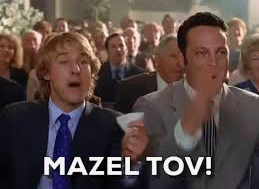Felicia & David
Jewish Weddings 101

Question
Bedeken (veiling)
Answer
The bedeken ceremony is next. Bedeken means “covering,” and it is the ritual moment in which the groom sees his bride’s face before covering it with the veil. Once David has made sure that Felicia's parents didn’t deviously swap in one of her sisters as happened to Jacob in the Torah, he will veil her (bedeken). This is David and Felicia’s chance to take one last long look at each other — not posing for yet another photo, but an opportunity for us to look at each other as individuals and affirm that we are choosing, without mistakes and freely, to marry one another.
Question
Signing the ketubah (marriage contract)
Answer
The ketubah, Jewish marriage contract, is signed by two Jewish witnesses. This document will be read during the wedding ceremony and outlines the values and actions that form the foundation of our new relationship.
Question
Chuppah (wedding canopy and ceremony)
Answer
The public ceremony begins! In Jewish weddings, it is tradition for both parents to walk both the groom and the bride down the aisle, signaling a transition for both. David and Felicia begin together outside of the chuppah (the wedding canopy) to symbolize the joining of two independent lives. Felicia will walk around David three times, representing the 3 levels of the soul: nefesh, neshama, and ruach, which are then braided together. We will stand under the chuppah, our metaphorical home, and a symbol of the home we have been building, and will keep building, together. Open on four sides, it represents the tent of Abraham and Sarah, a tent always open to family and friends.
Question
Nisuin/Sheva Brachot (Marriage and the Seven Blessings)
Answer
Still just betrothed, now we get married! Seven blessings (sheva brachot) are recited over a second cup of wine -- sanctifying the wine and the moment, praising creation, praising humanity, praising the creation of humanity in the divine image, hope for the future, a prayer for our happiness as a couple, and a final blessing combining hope and happiness. During the ceremony, we will wrap a tallit (prayer shawl) around ourselves to symbolize the private life we will share together.
Question
Smashing the Glass
Answer
One of the most well-known Jewish wedding traditions is the smashing of the glass. There are several explanations for this ritual, including reminding us the world is fragile and expressing hope our marriage will last as long as it takes to put the pieces back together (forever!). As the glass shatters, so do our lives as single people. The shattering of the glass is as permanent and irrevocable as our new commitment to each other. Another interpretation reminds us that even at one of our happiest moments, we must remember that we live in a world that is, in many ways, broken. The glass breaks today to remind us that our work to build a world of love and compassion is not over. It is traditional for the community to say “mazel tov!” when we smash the glass – that means “congratulations!” Now, the celebration begins!
Question
Yichud (time alone)
Answer
Some alone time. David and Felicia will take a few minutes on their own to breathe, drink some water, eat some snacks, and enjoy their first moments alone as husband and wife. Our guests will enjoy schmoozing over cocktails and hors d'oeuvres.
Question
Seudat Mitzvah (party)
Answer
Rejoicing with the happy couple is a Jewish obligation! Eat! Dance! Drink! The reception will begin with a traditional Jewish circle dance (hora). It literally involves running around in concentric circles and occasionally jumping up and down and clapping. If you thought you’d just come to the wedding, congratulate us, and then have a pleasant day, think again! According to Jewish tradition, guests are obligated to rejoice with the married couple. Your happiness today will add to ours, so we can’t wait to see you out on the dance floor!